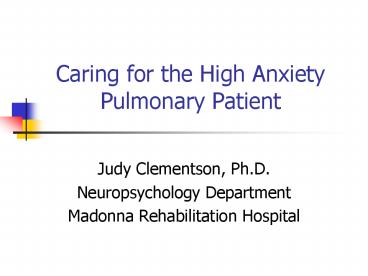Caring for the High Anxiety Pulmonary Patient - PowerPoint PPT Presentation
1 / 27
Title:
Caring for the High Anxiety Pulmonary Patient
Description:
Often, no triggering event is present. Catastrophic Interpretations: 'I'm suffocating,' 'I'm dying' (may be no obvious ... Hypervigilance: excessive focus on ... – PowerPoint PPT presentation
Number of Views:45
Avg rating:3.0/5.0
Title: Caring for the High Anxiety Pulmonary Patient
1
Caring for the High Anxiety Pulmonary Patient
- Judy Clementson, Ph.D.
- Neuropsychology Department
- Madonna Rehabilitation Hospital
2
Overview
- Anxiety and panic
- description and etiology
- Pulmonary patient anxiety
- Risk factors
- Triggers
- Anxiety approaches and interventions
- Management of panic attacks
3
What is anxiety?
- A response to anticipated danger
4
Components of Anxiety
5
Panic Attack vs. Anxiety
- PANIC
- Sudden onset
- Episodic
- More intense experienced as genuinely
life-threatening
6
Development of Panic Attack
- Often, no triggering event is present
- Catastrophic Interpretations Im suffocating,
Im dying (may be no obvious triggering event) - Hypervigilance excessive focus on any internal
feeling or sensation - Physiological Arousal actual increased RR, HR,
etc.
7
Panic Attacks Consequences
- Safety Behaviors Reliance on other people or
behaviors that the patient thinks will decrease
danger, e.g., using the call light constantly,
calling out, not wanting to be alone, requesting
suctioning or anxiety medication frequently - Magical safety thoughts (or superstitious
thinking) My safety behaviors protect me they
alone keep me safe. - Physical arousal increased dyspnea and
respiration rate, rapid heart rate, weakness,
nausea due to respiratory status, medical
factors, or psychological factors
8
Mechanism for Anxiety DevelopmentClassical
Conditioning
- Physiologically-based
- Association is formed between dangerous event and
other factors present at the time of danger - These factors then trigger anxiety even when
danger is not present - Develops easily and is VERY hard to extinguish
9
Development Of Behavioral Responses to Anxiety
Operant Conditioning
- Consequences of actions influence the probability
of repeating the actions - Behaviors that ? desired consequences (feeling
safer) increase, e.g., call light use, staying in
bed actions? anxiety are avoided - Need to help person feel safe via use of
approaches described below rather than
non-adaptive behaviors
10
What about anxiety/panic in pulmonary patients?
- Similar to general anxiety
- Physiological symptoms
- Thoughts/emotions
- Response to treatment
- Significantly Different
- Initially triggered by a biological survival
response that goes awry - For many, resolves entirely as respiratory status
improves
11
Pulmonary Patient AnxietyExplanatory Models
- Hyperventilation model
- Carbon dioxide hypersensitivity model
- Cognitive behavioral model
12
Factors Increasing Anxiety Risk in Pulmonary
Patients
- Genetic predisposition?anxious/timid temperment
- Early learning history
- Substance abuse history
- Recent history of medical and/or other trauma
- CO2 hypersensitivity
- Confusion/dementia
13
Epidemiology of Pulmonary Anxiety
- 3x higher in COPD patients than in the general
population - Rates are even higher in patients with
co-morbidities, e.g. heart failure, cancer - Panic attacks reported by more than 1/3 of COPD
patients - Lifetime prevalence of respiratory disease higher
in people with panic disorder (47) than in other
psych dx
14
Impact of Anxiety on Pulmonary Patients
- Decreased functional status
- Decreased quality of life
- Disease characteristics of COPD
- ?FVC, ?chest symptoms, ?dyspnea
- Frequency of hospital admission for acute
exacerbations - Duration of hospital stay twice as long
15
Treatment Goals
- Reduction in anxiety intensity and in frequency
of panic attacks, via - More adaptive beliefs about safety and
self-efficacy - Decreased physiological arousal
- New responses/behaviors to anxiety triggers
- Improved respiratory status
16
Approaches/Interventions
- Based on Cognitive/Behavioral and Medical Models
- Core principle
- To decrease anxiety, we must help the patient to
feel safe, emotionally and physiologically - This usually requires a relationship of trust,
built up over time, in addition to specific RT,
medical and psychological interventions
17
Medical Interventions to Decrease Physiological
Symptoms
- Respiratory treatments, vent setting changes, O2
increase, etc. - Medications Buspar, antidepressants, limited use
of benzodiazepams, very limited use of
neuroleptic medications
18
Behavioral Interventions
- Graduated exposure and desensitization
- weaning, exercise
- Pursed lip breathing
- Progressive muscle relaxation
- Imagery
- Music
19
Cognitive Interventions Education
- Medical status and safety
- Understand and trust external monitors
- O2, RR
- Anxiety
- worst before the feared event
- Will decrease with breathing, exercise, exposure
to feared stimulus such as weaning or walking
20
Learning Pyramid
21
Cognitive Interventions Changing Thoughts/Beliefs
- Cognitive Therapy
- Situation
- Feelings
- Automatic thought
- Cognitive Distortion
- Rational/realistic thought
- Feelings resulting from realistic thought
22
Increasing Coping Ability
- Problem-oriented coping vs.
- emotion-focused coping
- Focus on strengths, positives
23
Psychological Interventions
- Nurturing attitude
- Low key, calm, reassuring style
- Help patient to stop fighting anxiety
- Respond to all patient questions ask if patient
has questions
24
Panic Attack Approaches
- Learn to identify early warning signs
- Dont fight panic ride the wave
- Learn to talk yourself through it
- Use coping statements during and after
- This is anxiety, not a medical crisis
- I can do this
- This will end. Ill be tired but OK
25
Interventions for Cognitively Impaired Patients
- Family education and support
- Emotional support from family and staff
- Distraction
- Deep breathing, if previously learned
- Medications with immediate anxiolytic effects
26
Evidence of Treatment Effectiveness
- One 2-hour session of Group CBT with 6 weekly
follow-up calls - Pulmonary rehab programs
- Progressive muscle relaxation
- Pursed lip breathing
- Anti-depressants and Buspar
- Benzodiazepams for immediate relieflimit use as
much as possible
27
Summary
- High anxiety pulmonary patients present many
challenges - Excellent, effective care is possible when
knowledgeable, caring RTs work with the patient - Thank you!































